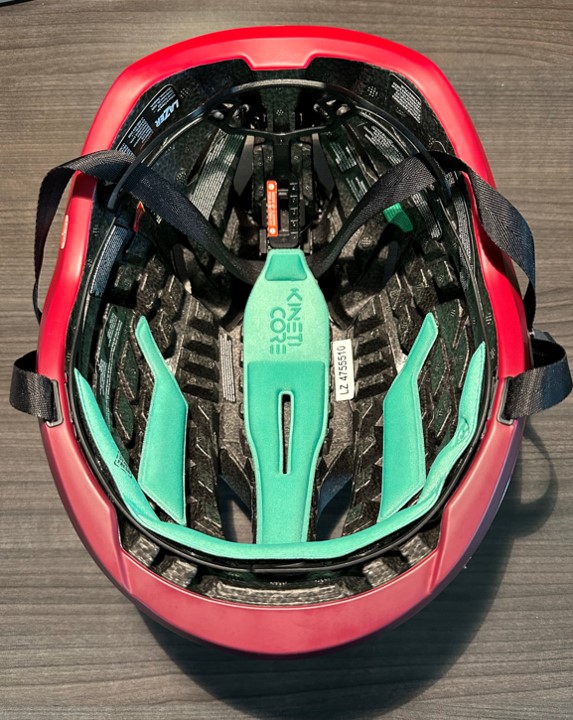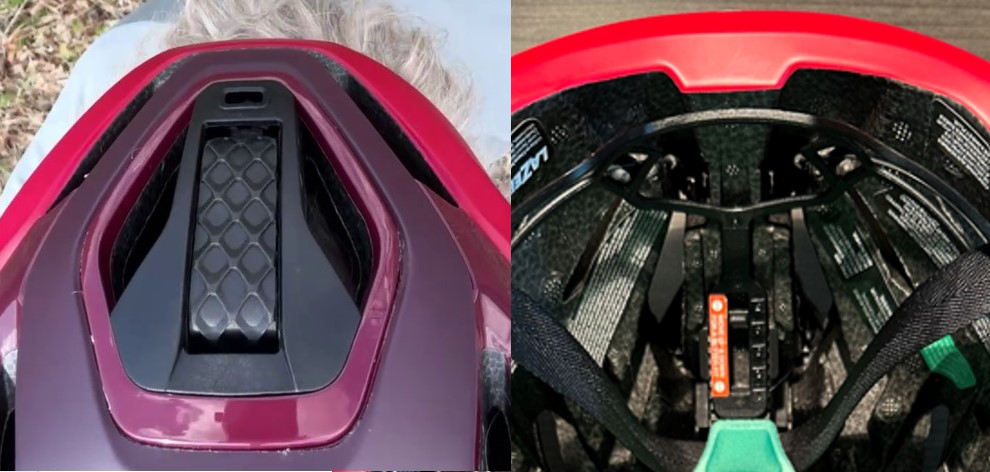LAZER VENTO KINETICORE – 5-STAR SAFETY; LOWER OVERALL RATING

Nothing about the Lazer Vento KinetiCore helmet thrills me.
Yes, it does get a top, 5-star rating in Virginia Tech’s helmet impact tests. These tests claim to “evaluate a helmet’s ability to reduce linear acceleration and rotational velocity of the head resulting from a range of head impacts a cyclist might experience.”
Lazer’s Kineticore safety system is also well integrated into the Vento helmet rather than applied as an overlay the way many early MIPS helmets were. It combines a series of 5-10mm wide and deep raised trapezoid shapes molded into the inner shell and 3 foam pads running down the center with another across the brow on a slip frame.

Lazer’s KinetiCore safety system uses a combination of raised blocks and a slip frame to allow your head to rotate inside the helmet.
So that’s all good.
But 106 other road helmets also get a 5-star rating and the Lazer Vento KinetiCore’s test score is bested by 101 of them.
The Vento also trails other aero road helmets we’ve tested in the more qualitatively judged categories of fit, comfort, function, and form.
FIT IS CHALLENGED BY SUBPAR ADJUSTMENT COMPONENTS
Some of its Lazer Vento KinetiCore fit adjustments are unique while others are old school.
For example, where many other top-of-the-line models now use a dial that hangs below the helmet’s back edge to adjust its circumference strap, the Vento uses a tractor-like belt built into the top of the shell for that purpose. However, when I tighten the circumference belt, the conventional tab mechanism that sets the height of the plastic frame meant to cradle the back of my head slides that frame up rather than staying in the place where I set it.

The unique tractor belt used to tighten the head circumference strap inadvertently changes the conventional height adjustment setting
And, where other helmet brands now sew the down straps that come together below your ears or use a locking clip to join them firmly in place, the Vento KinetiCore uses a more traditional threading clip that holds your adjustment in place, or not, based on the resistance to movement the straps offer to the clip.
Yet, I find the straps on the Vento to be relatively thin and pliable – my notes say “flimsy” – such that I had to regularly readjust the clip during my testing of this helmet.
Lazer also uses a standard buckle mechanism that works well to bring the right and left straps together below my chin. The strap length was just right and didn’t require any cutting. The extra length is held firmly in place by a rubberized band.
Whereas my head shape fits a helmet shape somewhere between the most round and oval ones, the Lazer Vento KinetiCore seems more suited to and would likely fit rounder heads better than mine.
COMFORT AND FUNCTIONALITY ARE LACKING
Without being able to dial in the Vento’s fit, I find it hard to get as comfortable in this helmet as others. Riding on all but the smoothest roads and on windy days, the Vento doesn’t quite seem to feel secure on my head. That’s discomforting in and of itself.
But it’s not just the fit that challenges the comfort level.
The pad running down the center of the helmet stops at the top of my head. I wish it didn’t; my head easily feels the shell at that point. The pads across the forehead to either side of the center strip are welcome yet compress far more easily than those in other helmets.
When I’m doing a hard group ride or intervals in temps around 65F/18C, the Vento doesn’t let enough vento (wind) through its openings to keep my head cool.
I’m not an aeronautical or fluid dynamics engineer and don’t pretend to play them in my reviews. But as a cycling consumer, one look at the Lazer Vento tells me it isn’t likely to have good as much cooling airflow as other aero helmets I’ve tested and may not be the most aerodynamic of designs.
There are just two vents in the front of the helmet, both in the center, and the exhaust vents on the top and in the back are small. Is this design the reason my head doesn’t stay cool on warm days?
Most of the original aero road helmets had similar issues but that was two or more model generations ago. Cooling is not an issue for the best models now and even those I rate average cool better than the Vento.
Does the minimal vent design lead to maximal aero performance? It’s hard to know without a wind tunnel. Once again, being the circumspect cycling enthusiast consumer that I am, a simple look makes me wonder.
Yes, the surface is smooth and with fewer cutouts in the front, the air might flow more aerodynamically across it. But the front of the helmet has good-sized indents along the sides that would seem to capture air and create turbulence that would be hard to reattach to the helmet area behind them.
Sunglasses of various sizes that I’ve worn haven’t interfered with the Lazer Vento KinetiCore across my forehead or above my ears. However, the absence of vents or cutouts along the sides of the front of the helmet gives you no place to dock sunglasses. You can put them through the outermost rear exhaust vents, but it takes some work and requires two hands, something I don’t advise that you do underway on all but the smoothest surfaces in still breezes (see Froome, Chris for more).
A STYLE ALL ITS OWN
Stylistically, the Vento KinetiCore appears to be putting its stamp on some of the latest helmet styling trends. With its combination of glossy and matt finishes and other unique styling aspects that I’ll describe below, I would guess Lazer was going for a look that stands out in the aero-road helmet field.
Yet the red-burgundy combination I tested – the brightest combination – to me looks quite subdued. Perhaps that’s because the largest surface area of the helmet has a matt finish whether it’s the burgundy color on the helmet I tested or the black, white, or blue on the others. A fellow enthusiast in my club wears the white helmet Vento with black highlights that also seems more modest than modern.
Whether it is or not, the Vento shell also appears to be created in sections – the matt-finish large center-middle, two glossy colored sides, a section surrounding the circumference adjusting belt in the back, and a matt-finish bottom section on which the others sit.
It’s another aspect that makes the helmet unique but for me, not particularly appealing as the sections create many junction lines where they come together.
Altogether, the combination of these fit, comfort, function, and form inconsistencies make it seem that the Lazer Vento KinetiCore was designed by putting some new and unique but untested approaches together with some tried and true but earlier generation ones. It feels and looks less like a finished or well-executed design and more like a prototype awaiting feedback and further improvements.
At a price of US$300, £249, €300 and available through these links to BTD (BikeTiresDirect), Competitive Cyclist, Performance Bike, Sigma Sports, and Amazon, it would take someone with a more suitably shaped head than mine who rides in mild temperatures and appreciates the look of Lazer Vento KinetiCore better than I do.
In The Know Cycling is ad-free, subscription-free, and reader-supported. If you want to help keep it rolling without any added cost to you, buy your gear and kit after clicking the store links on the site. When you do, we may earn an affiliate commission that will help me cover the expenses to create and publish our independent, comprehensive, and comparative reviews. Thank you, Steve. Learn more.
You can compare this helmet to competitively performing models in my review of the Best Aero Helmet for Road Cyclists.